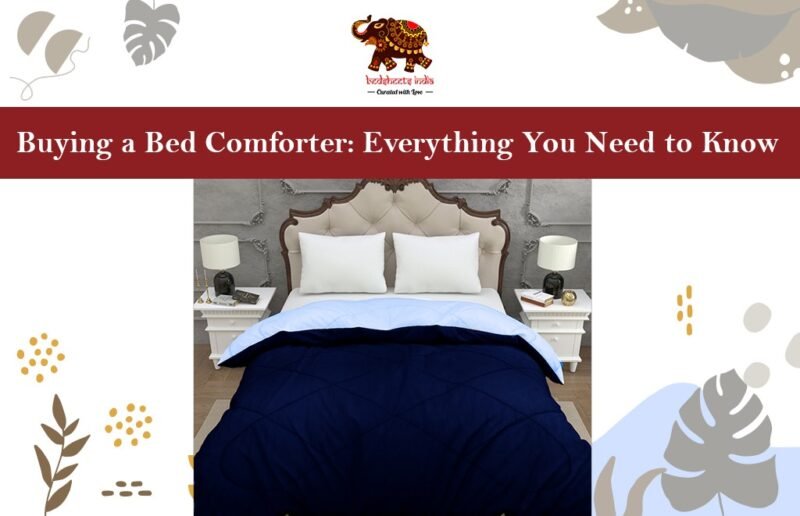
Investing in the ideal comforter for your bedroom offers you the chance to improve the appearance of your sleeping area and keep you warm on chilly evenings. With many options available, choosing the right comforter involves considering various factors, from fabric and filling to warmth and construction. In this comprehensive guide, we’ll walk you through everything you need to know to make an informed decision, ensuring that your investment not only provides comfort but also complements your style and preferences. From understanding the difference between down and alternative down to knowing the best time to make your purchase, let’s embark on the journey of finding the ideal comforter for your bed.
What is Bed Comforter?
A comforter is a bedding that serves both functional and aesthetic purposes in a bedroom. It is a thick, quilted blanket typically filled with insulating materials to provide warmth during sleep. Comforters are designed to be placed on top of the bed, covering the mattress and often extending over the sides and foot of the bed.
The outer shell of a comforter is usually made from a soft and decorative fabric, and the interior is filled with various materials to create the desired level of insulation. Common filling materials include down (the soft under feathers of ducks or geese), feathers, synthetic fibres, and wool. The choice of filling affects the comforter’s weight, warmth, and overall feel.
Comforters come in various sizes to accommodate different bed dimensions, such as twin, full, queen, and king sizes. They also vary in warmth levels, making it possible for individuals to select a comforter that suits their preferences and the climate of their location.
Unlike duvets, which require a separate cover, comforters often come with an integrated covering made from the same material as the outer shell. Because of this, they are a popular and practical option for bedding, offering both functional comfort and a decorative touch to improve the bedroom’s aesthetic appeal.
How to Choose a Bed Comforter?
Selecting the ideal bed comforter requires considering several aspects to ensure it complements your style and way of life. Here’s a guide on how to choose a comforter:
Comforter Size:
Select a comforter size that matches your mattress size. There are four standard sizes: twin, full, queen, and king. Ensure the comforter is large enough to drape over the sides of the bed for a stylish look.
Comforter Fabric:
Pick a fabric that complements your style and lifestyle. Common options include:
- Cotton: Breathable, durable, and easy to clean.
- Linen: Lightweight and breathable, suitable for warmer climates.
- Microfiber: Soft and hypoallergenic, with good durability.
- Silk: Luxurious, smooth, and lightweight.
- Comforter Filling: Consider the filling material based on your warmth preferences and any potential allergies:
- Down: Lightweight, insulating, and luxurious (from ducks or geese).
- Feathers: Heavier than down, providing warmth and support.
- Synthetic fibres: Hypoallergenic and suitable for those with allergies.
- Wool: Naturally breathable and regulates temperature well.
Warmth Level:
Comforters come in different warmth levels, such as lightweight, medium, and extra-warm. Choose a warmth level based on your local climate and personal preferences.
Seasonal sales, especially during the transition between seasons, to get the best deals on comforters.
Consider the Difference Between Down and Alternative Down:
Evaluate the pros and cons of natural down and synthetic alternatives. Down is often more luxurious but may concern animal welfare, while alternative down can be hypoallergenic and more budget-friendly.
- Check Out the Construction:
Look for features like baffle-box construction, which prevents the filling from shifting and ensures even distribution. High-quality stitching and reinforced edges contribute to the durability of the comforter.
- Read the Care Label for Cleaning Instructions:
Different comforters have specific cleaning requirements. Some may be machine washable, while others require professional cleaning. Always adhere to the care instructions to maintain the longevity of your comforter.
- Know the Best Time to Buy:
Knowing the best time to buy a comforter can help you save money and take advantage of discounts or promotions. Consider the following tips:
- End-of-Season Sales:
Retailers often discount bedding items at the end of each season to make room for new inventory. Look for sales from winter to spring or summer to fall.
- Holiday Sales:
Major holidays, such as Presidents’ Day, Memorial Day, Labor Day, and Independence Day, often feature sales on home goods, including cotton bedding. Keep an eye out for holiday-themed promotions.
- White Sales:
Historically, January has been associated with “White Sales,” where retailers offer discounts on bedding and linens. This tradition has evolved, and you can find sales on comforters during this time.
- Clearance Events:
Check for clearance events or sales when retailers need to clear out older inventory to make way for new arrivals. This can happen at various times throughout the year.
- Online Retailer Promotions:
Keep an eye on online retailers that may offer exclusive promotions or discounts. Sign up for newsletters or follow your favourite businesses on social media to find out about upcoming sales.
- Retailer Anniversary Sales:
Some retailers celebrate their anniversary with special promotions. Take advantage of these events to score discounts on bedding, including comforters.
- Off-Peak Shopping:
Consider shopping during off-peak seasons when demand for bedding may be lower. Retailers are more inclined to offer discounts to attract customers during these times.
Remember to plan and research prices before purchasing to identify genuine deals and make informed decisions. Additionally, watch for loyalty programs or exclusive online offers that can further enhance your savings.
Consider the Difference Material and Alternative Down:
Choosing between down and alternative down for your comforter involves considering material, insulation, and personal preferences. Here’s a breakdown of the differences between down and alternative down:
- Material: Ducks and geese have soft, fluffy undercoats called down underneath their outer feathers. It is a natural insulator with excellent loft.
- Insulation: Because of its remarkable warmth-to-weight ratio, down offers insulation without adding a lot of mass. It traps and retains body heat effectively.
- Luxury: Down is often associated with luxury and is appreciated for its lightweight feel and softness.
- Breathability: Down tends to be more breathable than synthetic alternatives, allowing for better temperature regulation.
Alternative Down:
- Materials: Alternative down refers to synthetic materials designed to mimic the properties of natural down. Common alternatives include polyester fibres and microfiber fill.
- Hypoallergenic: Many alternative down options are hypoallergenic, making them suitable for individuals with allergies to natural down.
- Cost-Effective: Alternative down comforters are often more budget-friendly than those filled with natural down.
- Animal Welfare: For individuals concerned about animal welfare, alternative down provides a cruelty-free option.
Considerations:
- Allergies: If you have allergies, consider choosing an alternative down comforter, as natural down may trigger reactions in some individuals.
- Budget: Down comforters, especially those with higher fill power, can be more expensive. Alternative down options provide a cost-effective alternative without sacrificing comfort.
- Ethical Concerns: Some people prefer alternatives for ethical reasons, as obtaining natural down may involve practices that raise concerns about animal welfare.
Fill Power:
Down Comforters: The fill power measures the loft or fluffiness of the down. Higher fill power indicates better insulation. Down comforters with a higher fill power are generally lighter and offer superior warmth.
Alternative Down Comforters: Fill power is less applicable to synthetic options, but the quality of the microfiber fill can still affect the comforter’s insulation properties.
How to Wash a Bed Comforter?
Washing a comforter depends on the specific care instructions provided by the manufacturer and the type of filling and fabric used. Here is a general guide on how to wash a comforter:
- Read the Care Label: Always check the care label attached to the comforter. The label provides essential information on washing instructions and any specific care requirements.
- Pre-Treat Stains: Before washing, pretreat any stains that may be present on the comforter. Use a mild stain remover or spot-clean with a gentle detergent to address specific areas.
- Use a Large Capacity Washer: Comforters, especially those for larger beds, may need to fit better in standard washing machines. Use a commercial or large-capacity washing machine to ensure proper cleaning.
- Choose a Gentle Detergent: Use a mild and gentle detergent to avoid damaging the fabric and filling. Harsh detergents may strip natural oils from down and reduce their insulation properties.
- Wash in Cold Water: Use cold water to prevent shrinking and preserve the quality of the fabric and filling. Warm or hot water can damage the comforter and affect its loft.
- Select a Gentle Cycle: Your washing machine should be set to a soft or delicate cycle to prevent overstirring, which could weaken the comforter’s structure.
- Rinse Thoroughly: Ensure the comforter is thoroughly rinsed to remove all detergent residue. Residual detergent can lead to skin irritation and affect the comforter’s performance.
- Dry Appropriately: Use a large-capacity dryer for comforters, and set it on a low heat or air-dry setting. Add tennis or dryer balls to help fluff up the filling and maintain the loft.
- Check for Dryness: Ensure the comforter is completely dry before removing it from the dryer. Any remaining moisture can lead to mould or mildew growth.
- Air Out and Fluff: Once the comforter is dry, air it out to eliminate any lingering odours. Please give it a good shake or fluff to restore its loft.
- Professional Cleaning: If the care label recommends professional cleaning, take the comforter to a reputable dry cleaner for proper care.
- Note: Remember that specific care instructions can vary based on the comforter’s materials, so following the manufacturer’s guidelines is crucial. If you need more clarification about washing your comforter at home, consider seeking professional cleaning services to ensure its longevity and performance.
FAQ
Can I use a duvet cover with my comforter?
Many comforters come with removable covers, or you can use a separate duvet cover for added protection and style.
How often should I wash my comforter?
Washing frequency depends on personal preference and usage. Generally, washing a few times a year is sufficient unless there are spills or stains.
Are down comforters suitable for people with allergies?
Some individuals may be allergic to down or feathers. In such cases, alternative down or hypoallergenic options are recommended.
Can I use a comforter without a top sheet?
Yes, a comforter can be used without a top sheet, but using one can help protect the comforter and extend its lifespan between washes.
What is the thread count, and does it matter for comforters?
Thread count refers to the number of threads per square inch. While it’s essential for sheets, it’s less critical for comforters. Focus on the overall quality and construction.
How do I store a comforter during the warmer months?
Store your comforter in a cool, dry place in a breathable bag to prevent dust and moisture buildup. Steer clear of plastic bags since they may retain moisture.
Can I use a comforter year-round?
Yes, but consider the warmth level. Lightweight comforters are suitable for warmer months, while heavier ones are better for colder seasons.
What is the lifespan of a Bed Comforter?
The lifespan varies based on quality and usage. A well-maintained comforter can last for several years.
Is it possible to repair a torn comforter?
Depending on the extent of the damage, you may be able to repair small tears or seams. For significant damage, professional assistance may be needed.
Can I iron my comforter?
It is generally not recommended to iron comforters, especially those with synthetic fillings, as high heat can damage the fabric and compromise the filling. Check the care label for specific instructions.
Conclusion – Buying a Bed Comforter
In summary, selecting the ideal bed comforter requires carefully weighing several variables to ensure the style and comfort suit your tastes. From the fabric and filling to the warmth level and construction, each element is crucial in enhancing your sleep experience. Timing your purchase during seasonal sales or special events can also save costs.
Understanding the difference between down and alternative down allows you to make an informed decision based on insulation, cost, and ethical considerations. Checking the construction, reading care labels for cleaning instructions, and following proper maintenance practices contribute to the longevity of your comforter.
The washing process demands attention to detergent selection, water temperature, and drying methods, ensuring your comforter stays fresh and maintains its quality over time. Addressing common questions about comforters provides valuable insights for a hassle-free ownership experience.
By investing time in understanding these aspects and personalizing your choice, you can enjoy a restful night’s sleep and transform your bedroom into a cosy and stylish bed comforter. Whether it’s the crisp freshness of a new comforter or the enduring warmth of a well-maintained one, your choice plays a pivotal role in curating the perfect sanctuary for relaxation and rejuvenation.














